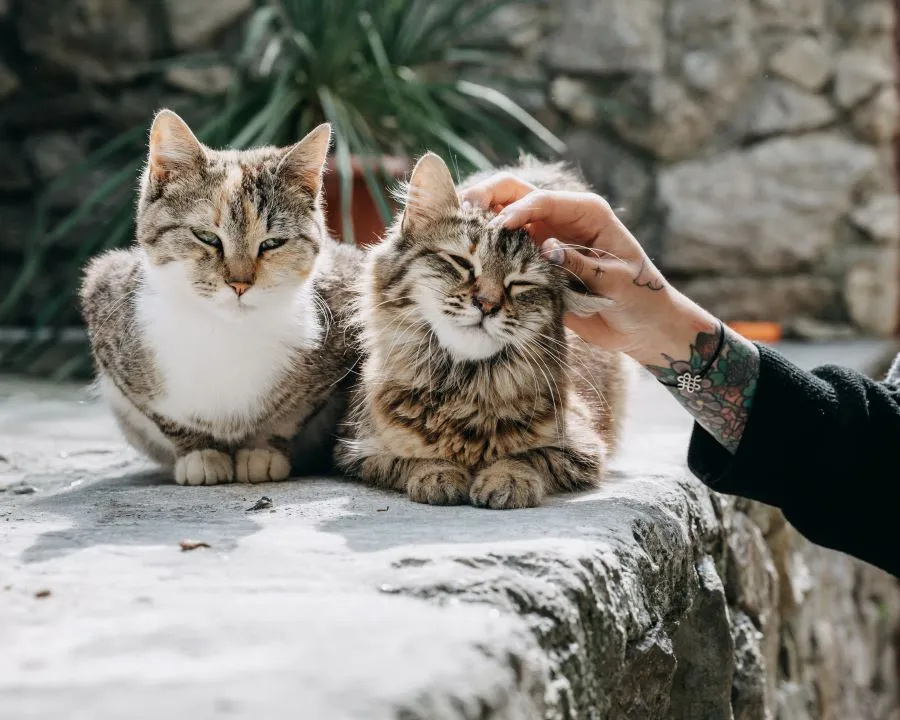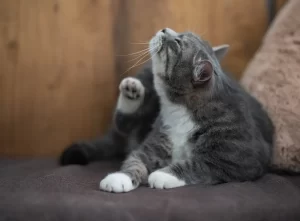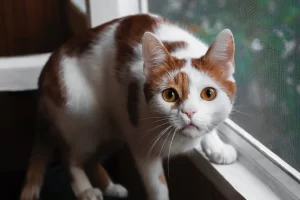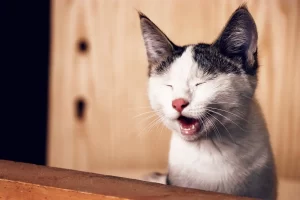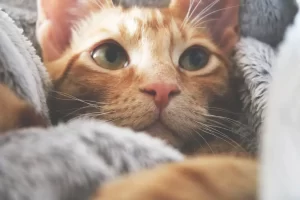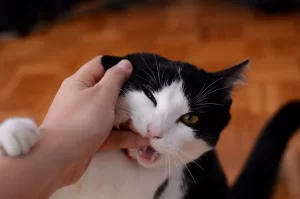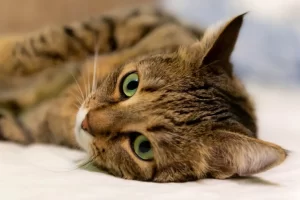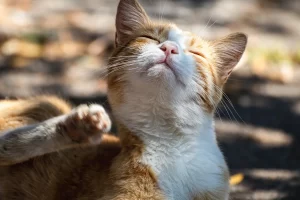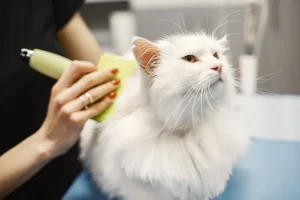Welcome to our comprehensive guide on “What Does It Mean When a Cat is in Heat?” If you’re a cat owner, you may have experienced or heard about the challenges and behaviors associated with a cat in heat. The feline estrus cycle, or heat cycle, is a natural reproductive process that female cats go through, but it can come with some noticeable changes in behavior and habits. In this article, we will cover everything you need to know about feline estrus cycle, including the signs of a cat in heat, the duration and frequency of the heat cycle, managing a cat in heat, and the importance of spaying and neutering in controlling the cat population. Let’s dive in and explore this topic in detail to help you better understand and manage your cat’s reproductive health.
Table of Contents
ToggleWhat Does it Mean When a Cat Is in Heat?
When a cat is “in heat,” it means that she is experiencing her estrus cycle, which is the reproductive cycle of female cats. During this time, a cat is fertile and ready to mate in order to become pregnant.
Definition of Feline Estrus Cycle
The feline estrus cycle, commonly known as a cat being “in heat,” refers to the reproductive cycle of female cats. It is a hormonal process that prepares the cat for mating and potential pregnancy. The estrus cycle typically occurs in sexually mature female cats that have not been spayed, and it is characterized by various physiological and behavioral changes.
During the estrus cycle, the cat’s ovaries release mature eggs, and her body produces hormones that attract male cats for mating. The estrus cycle is typically triggered by the lengthening daylight hours, and it can vary in duration and frequency depending on individual cats and breeds.
The feline estrus cycle is divided into four stages:
- Proestrus: This is the initial stage of the estrus cycle and typically lasts for 1-2 days. During proestrus, the cat’s vulva may swell, and she may exhibit increased restlessness and vocalization. However, she is not yet fertile and is not receptive to mating.
- Estrus: This is the stage when the cat is considered to be “in heat” and usually lasts for 4-7 days. During estrus, the cat becomes sexually receptive and may exhibit more intense signs of being in heat, such as persistent vocalization, rolling on the floor, and assuming the mating position. The cat may actively seek out male cats for mating during this stage.
- Metestrus: This is a transitional phase that occurs if the cat does not mate. It typically lasts for 2-3 days and is characterized by a decrease in the cat’s receptivity to mating.
- Anestrus: This is the final stage of the estrus cycle and is a period of sexual inactivity. It can last for several weeks to months before the cycle begins again.
Note that the estrus cycle can cause significant behavioral changes in cats, and unspayed female cats may exhibit signs of restlessness, vocalization, and seeking out male cats for mating during this time. Therefore, understanding the stages of the feline estrus cycle and recognizing the signs of a cat in heat can be valuable information for cat owners to effectively manage their cat’s reproductive health.
Signs of a Cat in Heat
When a female cat is in heat, she may exhibit various signs and behaviors that can be indicative of her reproductive status. These signs can vary in intensity and duration among individual cats, but commonly include:
- Increased Vocalization: Cats in heat often vocalize more frequently and loudly than usual. They may yowl, meow, or make other types of vocalizations to attract male cats for mating.
- Restlessness: Cats in heat may appear more restless and agitated than usual. They may pace, roam around the house, or exhibit repetitive behaviors like rolling on the floor or rubbing against objects.
- Changes in Posture: Cats in heat may assume a distinctive posture called the “lordosis” posture, where they lower their front end and raise their hindquarters in preparation for mating. This posture is often accompanied by a tail that is raised to one side and may quiver.
- Increased Urination: Cats in heat may urinate more frequently than usual and may exhibit spraying behavior, which involves marking vertical surfaces with urine to communicate their reproductive status to male cats.
- Changes in Scent Production: Cats in heat may produce stronger or different scents from their urine or genital area due to changes in their hormonal levels. This can also be a way for them to attract male cats for mating.
Keep in mind that these signs can be distressing for both the cat and the cat owner, as they may disrupt the cat’s normal behavior and sleep patterns. Additionally, unspayed female cats in heat may try to escape from the home to seek out male cats for mating, which can pose a risk of accidental pregnancy or getting lost.
Cat owners should be aware of these signs and behaviors of a cat in heat, and take appropriate measures to manage their cat’s reproductive health. This may include providing comfort and distraction to reduce stress, keeping the cat indoors to prevent mating or accidental pregnancy, and consulting with a veterinarian about spaying or other reproductive management options.
Duration and Frequency of Feline Estrus Cycle
The duration and frequency of the feline estrus cycle can vary among individual cats and different cat breeds. However, there are general patterns that can be helpful for cat owners to understand.
- Duration of Estrus Cycle: On average, the estrus cycle in cats typically lasts for about 4-7 days. However, the duration can vary, and some cats may have shorter or longer estrus cycles. The duration of each stage of the estrus cycle (proestrus, estrus, metestrus, and anestrus) can also vary among cats, but in most cases, estrus, the period when a cat is in heat and actively seeking mating, lasts for the majority of the cycle.
- Frequency of Estrus Cycle: The frequency of the estrus cycle can also vary among cats. In general, cats are known to be “seasonally polyestrous,” which means they can go into heat multiple times throughout the year, usually during the breeding season, which typically occurs in the spring and summer months. However, some cats, particularly those kept indoors with artificial lighting, may not exhibit a clear seasonality in their estrus cycles and may go into heat throughout the year.
- Individual Variation: It’s important to note that the duration and frequency of the estrus cycle can vary greatly among individual cats and different cat breeds. Some cats may have irregular estrus cycles, while others may have very regular cycles. Certain cat breeds, such as Siamese cats, are known to have more frequent estrus cycles compared to other breeds.
Understanding the typical duration and frequency of the feline estrus cycle can be helpful for cat owners to anticipate and manage their cat’s reproductive health.
Managing a Cat in Heat
Managing a cat in heat can be challenging due to the behavioral changes and inconvenience associated with the estrus cycle. However, there are several strategies that cat owners can implement to help minimize these issues and provide comfort to their cat:
- Provide Comfort: Cats in heat may experience discomfort due to hormonal changes and increased sexual arousal. Providing a safe and comfortable environment for your cat can help alleviate their stress. Ensure that your cat has a cozy and quiet space to rest, with access to food, water, litter box, and toys to keep them mentally stimulated.
- Reduce Stress: Cats in heat may become more anxious and restless. Minimizing stressors in their environment can help reduce their anxiety. Avoid loud noises, excessive handling, or changes in routine during this time. Providing calming aids, such as pheromone diffusers or supplements recommended by your veterinarian, may also help to reduce stress.
- Prevent Mating: If you do not want your cat to mate during their heat cycle, it’s important to prevent access to male cats. Keep your cat indoors to prevent mating or accidental pregnancy. If you have multiple cats, consider separating them during the heat cycle to prevent any unwanted mating.
- Consider Spaying: Spaying your female cat is the most effective way to prevent her from going into heat and experiencing the associated behavioral changes. Spaying is a surgical procedure that removes the ovaries and uterus, and it can be performed by a veterinarian. Spaying is a permanent solution for managing a cat’s reproductive health and can also prevent certain health risks associated with unspayed female cats, such as pyometra (a serious uterine infection) and mammary tumors.
- Consult with a Veterinarian: If you are experiencing difficulties in managing your cat in heat or considering spaying, it’s important to consult with a veterinarian. Your veterinarian can provide tailored advice and guidance based on your cat’s individual needs and circumstances, as well as discuss the potential benefits and risks of spaying or other reproductive management options.
By implementing these strategies, cat owners can help minimize the inconvenience associated with a cat in heat and provide comfort to their feline companion during this reproductive cycle. Home remedies for cats in heat are another way to calm down your cat when it is in heat.
Spaying and Neutering
Spaying and neutering are important procedures that can help manage the reproductive health of cats and prevent unwanted behaviors and pregnancies. Here are some key points to emphasize:
- Spaying Female Cats: Spaying, or ovariohysterectomy, involves removing the ovaries and uterus of female cats. This eliminates their ability to go into heat and prevents them from becoming pregnant. Spaying female cats can also reduce the risk of certain health issues, such as pyometra (a serious uterine infection) and mammary tumors. It is a permanent and effective way to control the cat population and prevent unwanted litters of kittens.
- Benefits of Spaying Female Cats: Spaying female cats can eliminate the behavioral changes associated with being in heat, such as increased vocalization, restlessness, and spraying. It can also prevent the inconvenience of managing a cat in heat and the potential risks of unwanted mating and pregnancy. Spaying is generally recommended by veterinarians as part of responsible cat ownership and population control efforts.
- Neutering Male Cats: Neutering, or castration, involves removing the testes of male cats. This can help manage their mating behavior, reduce the urge to roam, and prevent them from fathering unwanted litters of kittens. Neutering male cats can also reduce the risk of certain health issues, such as testicular tumors and prostate problems.
- Benefits of Neutering Male Cats: Neutering male cats can help prevent behaviors associated with mating, such as aggressive territorial marking (spraying) and roaming in search of females. It can also reduce the risk of fighting with other male cats, which can lead to injuries and transmission of diseases. Neutering is an effective way to control the cat population and prevent unwanted litters of kittens.
- Importance of Consulting with a Veterinarian: Spaying and neutering are surgical procedures that should be performed by a qualified veterinarian. It’s important to consult with a veterinarian to determine the optimal timing for spaying or neutering your cat, as well as to discuss any potential risks, benefits, and aftercare instructions. Your veterinarian can provide personalized advice and guidance based on your cat’s age, health status, and individual needs.
Frequently Asked Questions (FAQs) about Cats in Heat
What is the feline estrus cycle?
The feline estrus cycle, commonly known as “heat,” is the reproductive cycle of female cats.
What are the signs of a cat in heat?
Signs of a cat in heat may include increased vocalization, restlessness, changes in posture, increased urination, and changes in scent production.
How long does a cat stay in heat?
The duration of a cat’s heat cycle can vary, but on average, it lasts for about 4-7 days.
How often do cats go into heat?
Cats can go into heat multiple times a year, usually every 2-3 weeks, unless they are pregnant or spayed.
Can a cat get pregnant during heat?
Yes, a cat can get pregnant during heat if she mates with a male cat.
How can I manage a cat in heat?
You can manage a cat in heat by providing comfort, reducing stress, and preventing mating with male cats if desired.
Can I spay my cat while she is in heat?
Yes, it is possible to spay a cat while she is in heat, but it is generally recommended to wait until she is out of heat for the surgery.
Should I let my cat go outside during heat?
It is not recommended to let a cat go outside during heat, as she may attract male cats and increase the risk of unwanted pregnancies.
How can I calm down a cat in heat?
You can try providing a quiet and comfortable environment for your cat, offering distractions such as toys or treats, and providing extra attention and playtime.
How long does it take for a cat to get pregnant during heat?
If a cat mates with a male cat during heat, she can get pregnant within a few days.
Can male cats tell when a female cat is in heat?
Yes, male cats can detect the scent of a female cat in heat and may exhibit increased interest in mating.
How can I prevent my cat from going into heat?
Spaying (removing the ovaries and uterus) is the most effective way to prevent a cat from going into heat.
Can cats in heat be aggressive?
Some cats in heat may exhibit aggressive behaviors, but this can vary depending on the individual cat.
What can I do if I don’t want my cat to mate during heat?
You can keep your cat indoors, separate her from male cats, and provide a calm and stress-free environment during her heat cycle.
Can cats be spayed while they are pregnant?
Yes, cats can be spayed while they are pregnant, but it is generally not recommended unless there are specific health concerns.
Can cats get pregnant with multiple litters during one heat cycle?
Yes, cats can have multiple litters from different mates during a single heat cycle if they mate with multiple male cats.
Can cats be in pain during heat?
Cats may experience discomfort or mild pain during heat, but it is usually not severe.
How can I tell if my cat is in heat for the first time?
Signs of a cat’s first heat may include confusion, restlessness, and increased vocalization.
How old does a cat have to be to go into heat?
Cats can go into their first heat as early as 4-6 months of age, but it varies depending on the individual cat and breed.
Can cats in heat spray urine?
Yes, some female cats in heat may spray urine as a way to mark their territory and attract male cats.
Can cats in heat mate with their siblings?
Yes, cats in heat may mate with their siblings or other related cats, which can result in inbreeding and potential health issues for the offspring.
Can cats in heat be spayed without mating?
Yes, cats can be spayed without mating. Spaying (removing the ovaries and uterus) is a surgical procedure that can be done regardless of whether a cat has mated or not.
Can cats in heat have a false pregnancy?
Yes, some cats in heat may exhibit signs of a false pregnancy, such as nesting behavior and abdominal swelling, even if they have not been mated.
How can I prevent my male cat from mating with female cats in heat?
Neutering (removing the testes) is the most effective way to prevent male cats from mating with female cats in heat and reduce their mating behavior.
How long does it take for a female cat to recover from spaying?
The recovery time for a female cat after spaying can vary, but it typically takes about 7-10 days for the incision to heal and for the cat to fully recover.
Can cats in heat be spayed to stop the heat cycle?
Yes, spaying a cat can stop her heat cycle permanently, as the ovaries and uterus, which are responsible for the heat cycle, are removed during the surgery.
How can I tell if my male cat is neutered?
A neutered male cat will not have testicles and will have a small scrotal sac. A veterinarian can also confirm if a male cat has been neutered through a physical examination.
Are there any health benefits to spaying or neutering a cat?
Yes, spaying or neutering a cat can have health benefits, such as reducing the risk of reproductive-related health issues, such as uterine infections and testicular cancer.
Can cats in heat experience false labor or contractions?
Yes, some cats in heat may experience false labor or contractions, which can be accompanied by restlessness, vocalization, and other signs similar to those of labor.
When is the best time to spay or neuter a cat?
The best time to spay or neuter a cat is typically before they reach sexual maturity, which is around 4-6 months of age, but it is best to consult with a veterinarian for the most appropriate timing for your cat.

